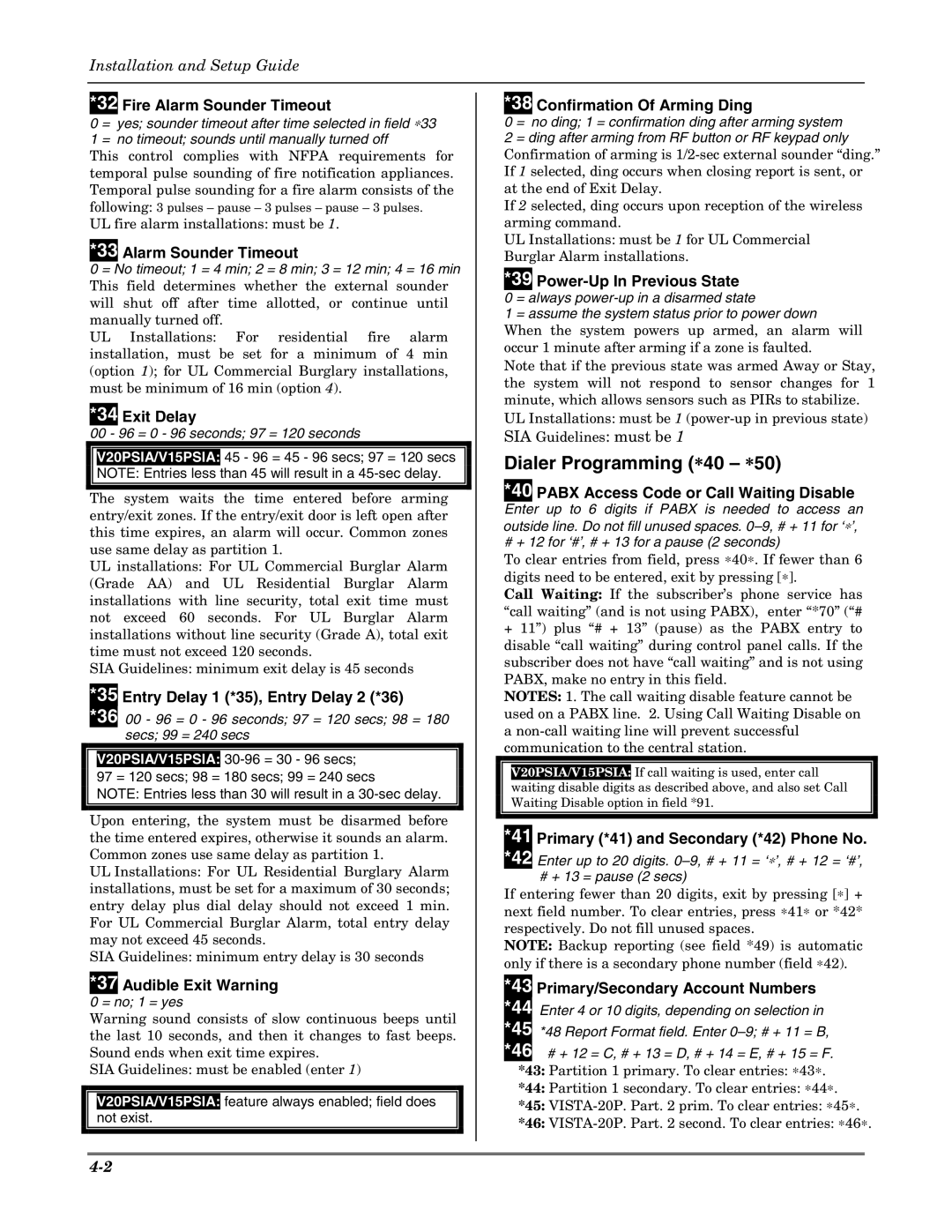
Installation and Setup Guide
*32 Fire Alarm Sounder Timeout
0 = yes; sounder timeout after time selected in field ∗33 1 = no timeout; sounds until manually turned off
This control complies with NFPA requirements for temporal pulse sounding of fire notification appliances. Temporal pulse sounding for a fire alarm consists of the following: 3 pulses – pause – 3 pulses – pause – 3 pulses.
UL fire alarm installations: must be 1.
*33 Alarm Sounder Timeout
0 = No timeout; 1 = 4 min; 2 = 8 min; 3 = 12 min; 4 = 16 min This field determines whether the external sounder will shut off after time allotted, or continue until manually turned off.
UL Installations: For residential fire alarm installation, must be set for a minimum of 4 min (option 1); for UL Commercial Burglary installations, must be minimum of 16 min (option 4).
*34 Exit Delay
00 - 96 = 0 - 96 seconds; 97 = 120 seconds
V20PSIA/V15PSIA: 45 - 96 = 45 - 96 secs; 97 = 120 secs
NOTE: Entries less than 45 will result in a
The system waits the time entered before arming entry/exit zones. If the entry/exit door is left open after this time expires, an alarm will occur. Common zones use same delay as partition 1.
UL installations: For UL Commercial Burglar Alarm (Grade AA) and UL Residential Burglar Alarm installations with line security, total exit time must not exceed 60 seconds. For UL Burglar Alarm installations without line security (Grade A), total exit time must not exceed 120 seconds.
SIA Guidelines: minimum exit delay is 45 seconds
*35 Entry Delay 1 (*35), Entry Delay 2 (*36)
*36 00 - 96 = 0 - 96 seconds; 97 = 120 secs; 98 = 180 secs; 99 = 240 secs
V20PSIA/V15PSIA:
97 = 120 secs; 98 = 180 secs; 99 = 240 secs
NOTE: Entries less than 30 will result in a
Upon entering, the system must be disarmed before the time entered expires, otherwise it sounds an alarm. Common zones use same delay as partition 1.
UL Installations: For UL Residential Burglary Alarm installations, must be set for a maximum of 30 seconds; entry delay plus dial delay should not exceed 1 min. For UL Commercial Burglar Alarm, total entry delay may not exceed 45 seconds.
SIA Guidelines: minimum entry delay is 30 seconds
*37 Audible Exit Warning
0 = no; 1 = yes
Warning sound consists of slow continuous beeps until the last 10 seconds, and then it changes to fast beeps. Sound ends when exit time expires.
SIA Guidelines: must be enabled (enter 1)
V20PSIA/V15PSIA: feature always enabled; field does not exist.
*38 Confirmation Of Arming Ding
0 = no ding; 1 = confirmation ding after arming system
2 = ding after arming from RF button or RF keypad only Confirmation of arming is
If 2 selected, ding occurs upon reception of the wireless arming command.
UL Installations: must be 1 for UL Commercial Burglar Alarm installations.
*39 Power-Up In Previous State
0 = always
1 = assume the system status prior to power down
When the system powers up armed, an alarm will occur 1 minute after arming if a zone is faulted.
Note that if the previous state was armed Away or Stay, the system will not respond to sensor changes for 1 minute, which allows sensors such as PIRs to stabilize.
UL Installations: must be 1
SIA Guidelines: must be 1
Dialer Programming (∗40 – ∗50)
*40 PABX Access Code or Call Waiting Disable
Enter up to 6 digits if PABX is needed to access an outside line. Do not fill unused spaces.
# + 12 for ‘#’, # + 13 for a pause (2 seconds)
To clear entries from field, press ∗40∗. If fewer than 6 digits need to be entered, exit by pressing [∗].
Call Waiting: If the subscriber’s phone service has “call waiting” (and is not using PABX), enter “*70” (“#
+11”) plus “# + 13” (pause) as the PABX entry to disable “call waiting” during control panel calls. If the subscriber does not have “call waiting” and is not using PABX, make no entry in this field.
NOTES: 1. The call waiting disable feature cannot be used on a PABX line. 2. Using Call Waiting Disable on a
V20PSIA/V15PSIA: If call waiting is used, enter call waiting disable digits as described above, and also set Call Waiting Disable option in field *91.
*41 Primary (*41) and Secondary (*42) Phone No. *42 Enter up to 20 digits.
# + 13 = pause (2 secs)
If entering fewer than 20 digits, exit by pressing [∗] + next field number. To clear entries, press ∗41∗ or *42* respectively. Do not fill unused spaces.
NOTE: Backup reporting (see field *49) is automatic only if there is a secondary phone number (field ∗42).
*43 Primary/Secondary Account Numbers
*44 Enter 4 or 10 digits, depending on selection in *45 *48 Report Format field. Enter
*46 # + 12 = C, # + 13 = D, # + 14 = E, # + 15 = F. *43: Partition 1 primary. To clear entries: ∗43∗.
*44: Partition 1 secondary. To clear entries: ∗44∗.
*45:
*46:
